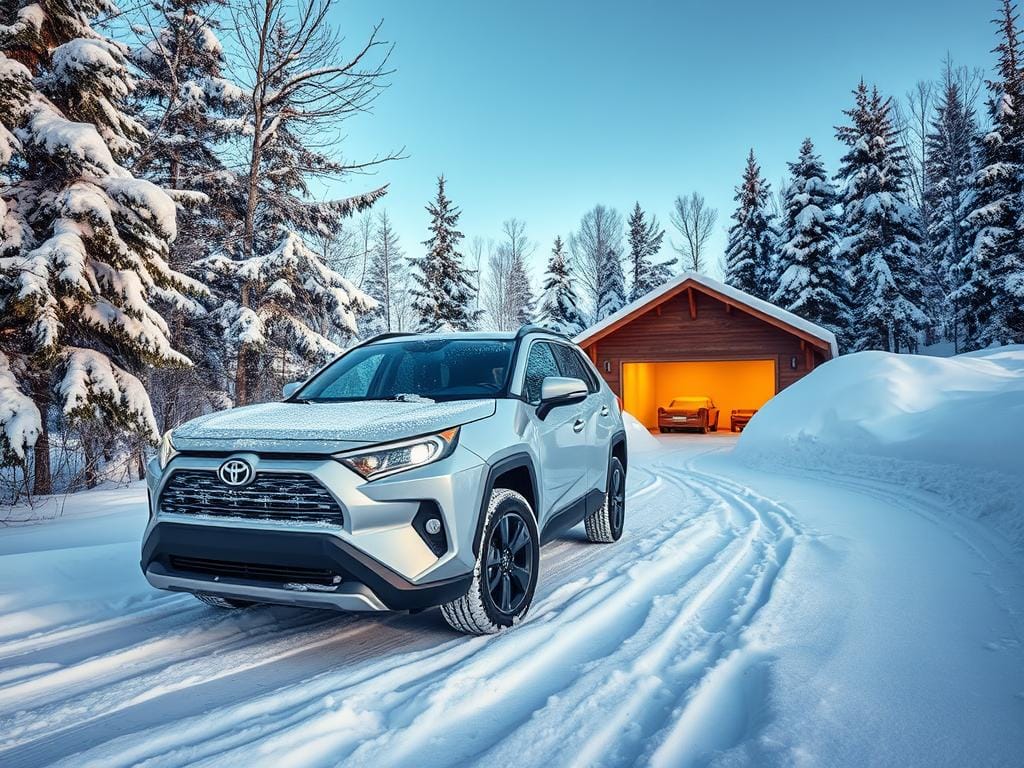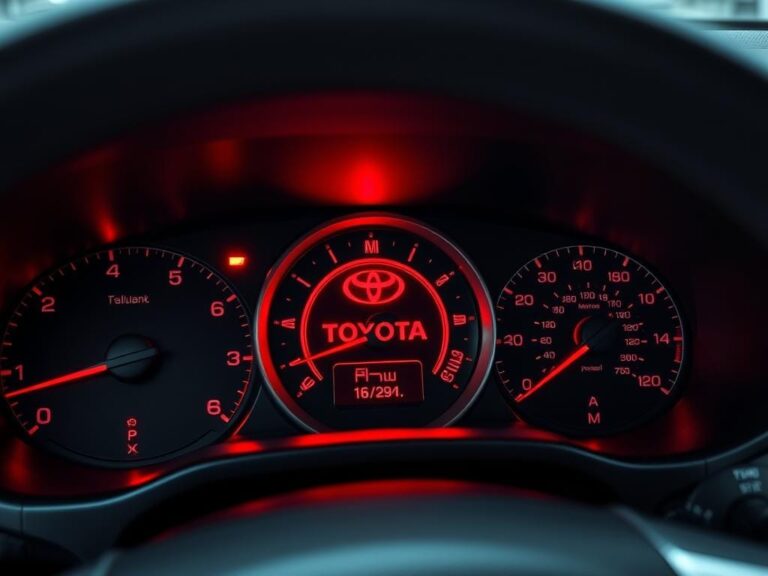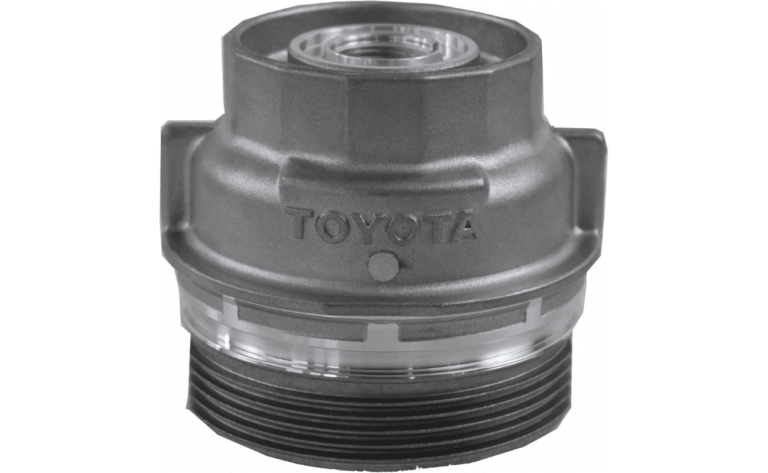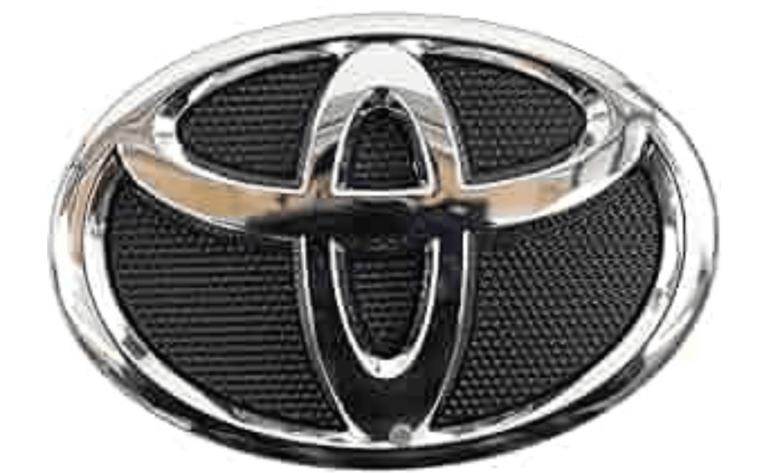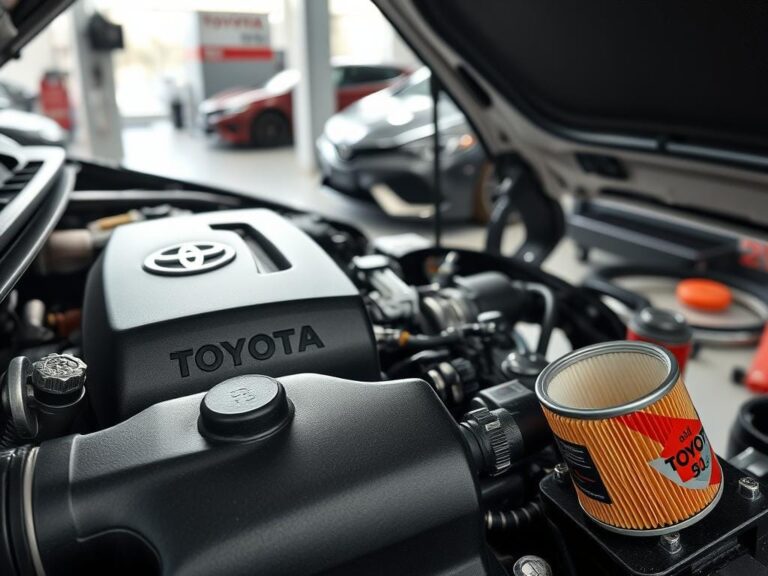How to Get Your Toyota Ready for Winter: A Step-by-Step Guide
Toyota Ready for Winter: Have you ever thought about how cold weather affects your car? As winter gets closer, it’s key to get your Toyota ready. This way, you can avoid breakdowns and stay safe on the road.
When it’s freezing, your car might start to have problems. These issues can be really dangerous. So, it’s important to know how to keep your car in top shape during winter.
We’ll share important tips on winter car care. You’ll learn about checking your tires and what to include in an emergency kit. With these tips, you’ll be ready to face winter with confidence!
Table of Contents
Importance of Winter Preparation
Winter weather brings many challenges that can affect your vehicle’s safety and function. To stay safe and avoid breakdowns, it’s key to winterize your Toyota. A detailed Toyota winter checklist helps you focus on important areas like tires, fluids, and safety gear.
Getting your vehicle ready for winter improves traction and safety. One crucial step is to check your tires for winter readiness. Many people don’t realize how much better winter tires are than all-season ones. Knowing this can make a big difference in staying safe on icy roads.
Fluid checks are also vital for winter. A 50/50 mix of water and coolant is best for your engine to avoid freezing. Also, check your battery’s health, especially if it’s over three years old. Cold weather can really hurt its performance.
Make maintenance a part of your winter routine. By doing this, you can improve your safety and performance. Stay up to date with winter car prep tips to drive confidently all season.
Checking and Replacing Tires
Having the right tires is key for your car’s performance in winter. It’s not just about picking the right ones. You also need to check them regularly to keep them working well. Knowing why winter tires are important and how to take care of them can make your drive safer.
Why Winter Tires are Essential
Winter tires are vital for staying safe on snowy and icy roads. They have special rubber and tread patterns for better grip. Unlike regular tires, they have deeper treads and softer materials for better braking and handling.
In Pennsylvania, look for tires made with special rubber for cold weather. Make sure your tires have at least 4/32 inches of tread for safe driving.
Proper Tire Pressure and Tread Depth
Keeping the right tire pressure is crucial in winter. Cold weather can lower tire pressure by about 1 PSI for every 10°F drop. Always check your tire pressure to match the manufacturer’s specs.
Low pressure can make your car use more fuel. Also, check your tread depth often. You should have at least 3/32 inches for safe driving in cold, wet conditions.
Uneven wear can mean your tires are not aligned right. This can lead to expensive repairs if not fixed. Ignoring tire care can make you more likely to skid or slide on ice. So, it’s important to check and maintain your tires often.
Fluid Checks: A Comprehensive Approach
Getting your Toyota ready for winter means checking essential fluids. It’s important to keep them in good shape for the cold. Here are some key areas to focus on, along with tips to keep your car safe in the cold.
Antifreeze Levels Matter
Antifreeze is key for your engine in cold weather, which can get as low as -30 °C. Make sure your antifreeze levels are right to avoid freezing and overheating. The right mix of antifreeze and water is crucial to avoid engine damage.
Windshield Wiper Fluid for Visibility
Clear visibility is essential for safe driving in winter. Use winter-grade windshield wiper fluid that works well in cold. Keeping your windshield wiper fluid topped up helps prevent streaks and keeps you safe in snow or icy rain. This is a key part of keeping your Toyota safe on the road.
Engine Oil Adjustments for Cold Weather
Using lighter oil, like 5W-30, can help your engine in cold weather. Cold weather can make oil thicker and hurt your engine. Regular oil changes in winter help reduce wear and tear, keeping your Toyota’s engine running well. Using the right fuel and fluids for winter driving also helps protect your car from the cold.
| Fluid | Ideal Condition | Winter Maintenance Tips |
|---|---|---|
| Antifreeze | Proper mixture to prevent freezing | Check levels regularly |
| Windshield Wiper Fluid | Winter-grade fluid | Top weekly for clear visibility |
| Engine Oil | Lighter oil like 5W-30 | Change every 3,000 miles or as needed |
| Brake Fluid | Clear and uncontaminated | Inspect for discoloration or deterioration |
| Transmission Fluid | Meet manufacturer specifications | Check levels and condition regularly |
Following these winter car maintenance tips will help your Toyota stay in top shape all winter. Stay on top of your fluid checks for safer travels in the cold.
Battery Health and Maintenance
Keeping your Toyota’s battery in top shape is key during winter. Cold weather can cut battery power by up to 35%, causing starting problems. Regular checks for wear can keep your car running smoothly. By following these winter battery tips, you can extend your battery’s life and avoid sudden failures.
Signs Your Battery May Need Replacing
Watch for signs that your battery might be failing. Dim headlights or slow engine starts are warning signs. Most car batteries last 3 to 5 years, so checking them before winter is crucial. About 30% of battery failures are due to corrosion, so regular inspections are important.
Tips for Strengthening Battery Performance
To boost your battery’s performance in cold weather, try these tips:
- Clean the battery terminals and cables to prevent corrosion.
- Consider having a professional battery test done in winter.
- Make sure the battery is securely fastened to avoid damage from vibrations.
- Drive your car at least 30 minutes a week to keep the battery charged.
- Use insulation to protect the battery from extreme cold, which can reduce starting power by up to 60%.
Prepare Your Toyota for Winter
Winter driving can be tough. It’s key to know about Toyota’s features for cold weather. These technologies help your car handle icy roads and freezing temperatures.
Assessing Your Toyota’s Performance Features
Your Toyota might have special features for snow and ice. Look for All-Wheel Drive, traction control, and stability systems. These help your car grip the road better, making driving safer and more confident.
Using Toyota Safety Sense for Added Protection
Every Toyota has Toyota Safety Sense. It includes features like pre-collision warnings and lane alerts. These help you stay safe and avoid dangers in winter.
Winter Driving Techniques
Learning how to drive safely in winter is key to staying safe on the road. Winter storms lead to 500,000 car crashes and over 2,000 deaths each year. Knowing how to drive in icy conditions can be a lifesaver. Here are some important tips for driving on icy and slippery roads.
Adapting Your Driving Style
Driving in winter means changing how you drive. It’s crucial to drive carefully and follow these tips:
- Slow down to keep control on slippery roads.
- Leave more space between you and the car in front to stop safely.
- Avoid quick starts and sharp turns to stay stable on icy roads.
- Keep your headlights on to see better during winter storms.
- Have at least half a tank of gas to prevent freezing and keep your heater working if you get stuck.
Tips for Handling Black Ice
Knowing about black ice is crucial for safe winter driving. This hidden danger forms in shaded spots and on bridges. Here’s what to do if you hit black ice:
- Drive steadily without sudden stops.
- Steer smoothly to get back on track instead of making quick turns.
- Watch for temperature changes, as black ice can form even when it’s not cold.
- If you start to slide, don’t panic; steer gently in the direction you want to go.
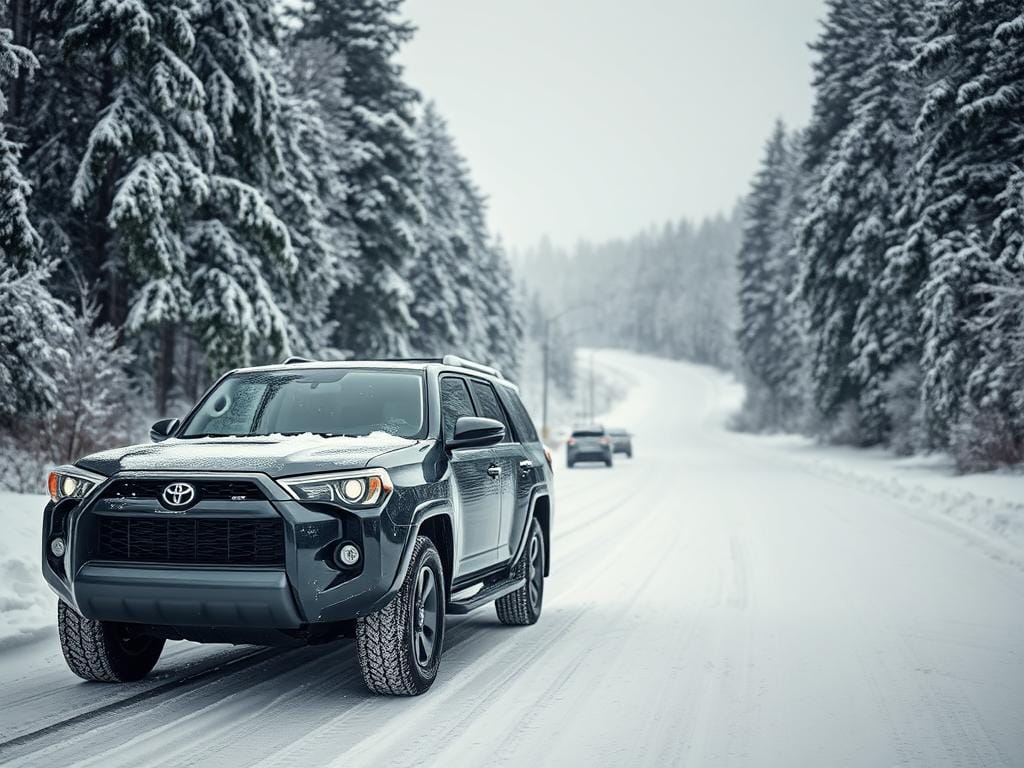
Emergency Kit Essentials
Being ready for winter emergencies is key, especially when driving a Toyota. A well-stocked winter emergency kit can greatly improve safety in unexpected situations. Make sure to include these items in your Toyota emergency supplies to be ready for winter car troubles.
Items to Include in Your Kit
- Warm blanket to keep you warm.
- Jumper cables (at least 12 feet) for quick starts.
- Flares and reflective triangles, 30 feet behind your car for safety.
- Ice scraper and snow brush for clear visibility.
- Non-perishable snacks and bottled water, updated every 6 months.
- Flashlight with extra batteries; LED is best for longer life.
- First aid kit with 10 basic items, like bandages and antiseptic wipes.
- Tire repair kit with sealant and inflator for quick fixes.
- Heavy-duty gloves and rain ponchos for weather protection.
- A bag of sand or cat litter for better traction.
- Tow rope or chain that matches your car’s weight.
- A multitool with at least five functions, like pliers and screwdrivers.
- Emergency foil blankets that reflect 90% of body heat.
- Automotive-rated fire extinguisher, checked yearly.
- Duct tape for quick repairs.
- Snow shovel for clearing paths or digging out your car.
How to Store Your Emergency Kit Effectively
To make sure you can reach your emergency kit in winter, keep it in a strong, waterproof bag or container. Place it in your Toyota’s trunk for easy access. Check your kit regularly, replacing expired items or refreshing non-perishable supplies. This way, you’ll always have the car safety essentials you need in winter.
Maintaining Visibility During Winter
Keeping your car visible in winter is key to staying safe. Make sure all windows are clear of snow and ice before driving. If you don’t, it can make driving risky.
It’s also important to keep your windshield wipers in good shape. Old or damaged wipers can’t handle snow and ice well. Get winter-grade wipers to keep your view clear.
Choosing the right windshield washer fluid is also crucial. Pick one that won’t freeze, so your windshield stays clean. Check your car’s lights and heating system too. This helps you see better when it’s dark and snowy.
Don’t overlook your car battery. Cold weather can weaken it a lot. Test it before winter to avoid breakdowns. A good heating system and clean air inside help keep windows clear.
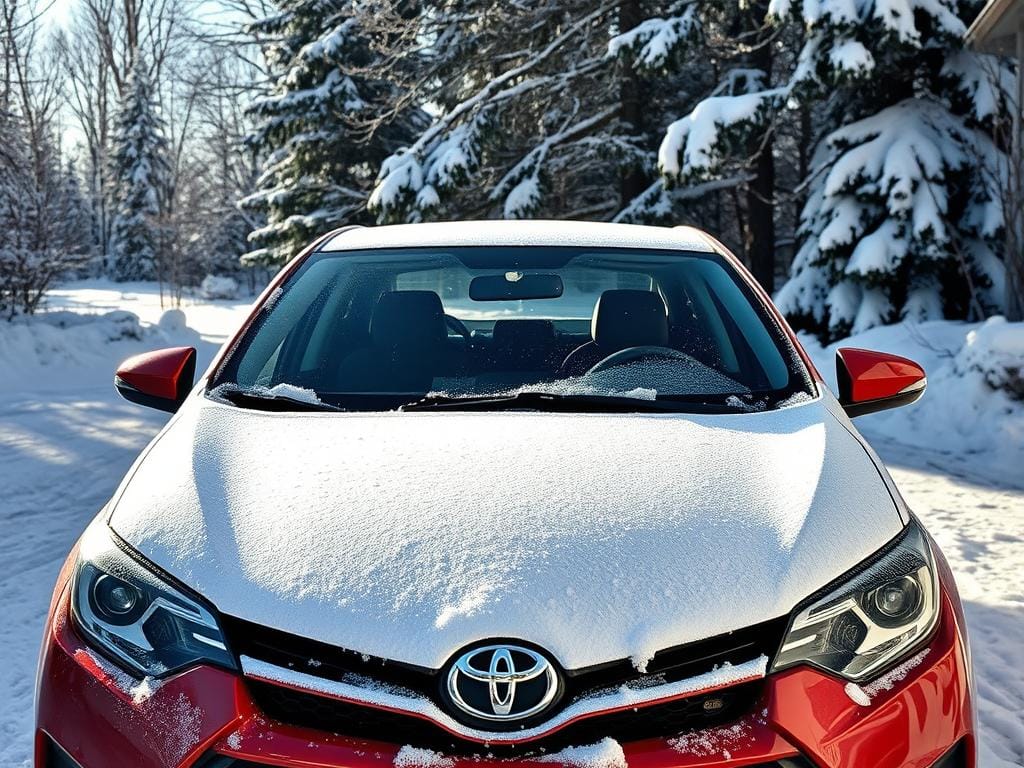
By following these tips, you can see better while driving in winter. This makes your trips safer and more confident.
Conclusion
As winter gets closer, it’s key to finish your Toyota winter prep. Make sure your car is ready for the cold weather. Check your tires, fluids, and battery to keep your car running smoothly.
Keeping your car in good shape keeps you safe and warm. It’s also important to check your brakes and cooling system. This way, you can avoid any car troubles.
Most drivers feel safer when their cars are winter-ready. Your car’s safety can boost your confidence and that of your passengers. So, make sure your car is ready for the cold.
Don’t forget to pack an emergency kit with jumper cables, blankets, and a flashlight. Regular car care and these kits can help you avoid car troubles. Stay safe and enjoy the winter!
Did You Like This Article?
Celica come back
Very informative and useful, details.
Good article
A lot information, thanks
Top top toyota
Celica 2025 is a top model of Toyota,
New Celica
I drove an ’81 from ’85 til ’99 and loved it. Then I got my first Nissan 240 SX. Twenty five years later, I’m on my fourth 240. Any chance of a 240SX comeback?
Toyota riders . Com
Very informative

